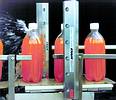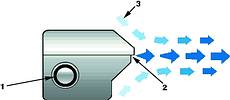
Almost every industrial facility has at least one compressor that is used for hundreds of different tools, equipment and operations. While most applications for compressed air present no real problems, some do. Improper use can translate into unnecessary energy costs, high noise levels and dangerous exposure of personnel to high-pressure air.
Reduce energy costs
The best way to cut energy costs is through proper maintenance and use of the compressed air system. Leaks and dirty filters require maintenance on a regular basis. Energy savings can also be realised when replacing outdated motors and controls with high efficiency models that often pay for themselves in a short period of time. The most important factor to dramatically boost efficiency is proper use. The Super Air Knife is said to use only a third of the compressed air normally required for typical blow-offs used in cleaning, cooling and drying operations and - can be instantly cycled on and off.
Reduce noise levels
High noise level is a common problem for many plants. Compressed air noise often exceeds OSHA (Occupational Safety and Health Administration) noise level exposure requirements, resulting in hearing loss to those working in close proximity. The sound level of the Super Air Knife is quiet at less than 70 dBA, even at high pressures of 550 kPa. The makers of the Super Air Knife say that it is possible to obtain hard-hitting force without the high noise.

Eliminate harmful dead-ended pressures
Compressed air can be dangerous when the outlet pressure of a hole, hose or copper tube is higher than 200 kPa. In the event the opening is blocked by a hand or other body part, air may enter the bloodstream through the skin, resulting in serious injury. The Super Air Knife has been engineered for safety and cannot be dead-ended. It is safe to operate at higher pressures and meets OSHA standard 1910.242(b).
Replacement for expensive, noisy blowers
Energy conscious plants might think a blower to be a better choice due to its slightly lower electrical consumption compared to a compressor. In reality, a blower is an expensive capital expenditure that requires frequent downtime and costly maintenance of filters, belts and bearings. Here are some important facts:
* Filters must be replaced every one to three months.
* Belts must be replaced every three to six months.
* Blower bearings wear out quickly due to the motor that must turn at 17 000 to 20 000 RPM in order to generate effective airflows.
* Poorly designed seals that allow dirt and moisture infiltration along with environments above 52°C decrease the one year bearing life.
* Many bearings cannot be replaced in the field, resulting in downtime to send the assembly back to the manufacturer.
* Blowers take up a lot of space and often produce sound levels that exceed OSHA noise level exposure requirements. Air volume and velocity are often difficult to control since mechanical adjustments are required.
Comparing blow-offs
There are a variety of ways to blow the water from the bottles shown in Figure 1. EXAIR performed tests to compare the performance of drilled pipe, flat air nozzles, a blower and its own Super Air Knife. EXAIR believes that its Air Knife is the superior candidate for blow-off, cooling or drying applications.

The goal for each of the blow-off choices was to use the least amount of air possible to get the job done (lowest energy and noise level). Compressed air pressure required for each was 410 kPa, which provided adequate velocity to blow the water off. The blower used had a 7,5 kW electric motor and was a centrifugal type blower at 18 000 RPM. Table 2 summarises the overall performance. Since different blower nozzles applications can be arranged in different configurations of holes, or sharp edges, these sound level measurements were taken in free air (no impinging surfaces).

Drilled pipe (Figure 2)
This common blow-off is very inexpensive and easy to make. For purposes of this test two drilled pipes were used, each with 25 1,6 mm diameter holes on 13 mm centres. As shown in the test results, the drilled pipe performed poorly. The initially low cost of the drilled pipe is overshadowed by its high-energy use. The holes are easily blocked and the noise level is excessive - both of which violate OSHA requirements. Velocity across the entire length was inconsistent - with spikes of air and numerous dead spots.
Flat air nozzles (Figure 3)
As shown in Table 2, this inexpensive air nozzle was the worst performer. It is available in plastic, aluminium and stainless steel from several manufacturers. The flat air nozzle provides some entrainment, but suffers from many of the same problems as the drilled pipe. Operating cost and noise level are both high. Some manufacturers offer flat air nozzles where the holes can be blocked - an OSHA violation. Velocity was inconsistent with spikes of air.

Blower air knife (Figure 4)
The blower proved to be an expensive, noisy option. As noted below, the purchase price is high. Operating cost was considerably lower than the drilled pipe and flat air nozzle, but was comparable to the EXAIR Super Air Knife. The large blower with its two 3" (76 mm) diameter hoses requires significant mounting space compared to the others. Noise level was high at 90 dBA. There was no option for cycling it on and off to conserve energy like the other blow-offs. Costly bearing and filter maintenance along with downtime were also negative factors.
EXAIR Super Air Knife (Figure 5)
Uniformity of the laminar airflow meant that this device proved capable of removing all the water in one pass. The sound level was significantly lower at 69 dBA. For this application, energy use was slightly higher than the blower but can be less than the blower if cycling on and off is possible. Safe operation is not an issue since the Super Air Knife cannot be dead-ended. Maintenance costs are low since there are no moving parts to wear out.
How the EXAIR Air Knife works
In Figure 6, compressed air flows through an inlet (1) into the plenum chamber. The flow is directed to a precise, slotted orifice. As the primary airflow exits the thin slotted nozzle (2), it follows a flat surface that directs the airflow as a flat, uniform sheet of air across the entire length of the device. Velocity loss is minimised and force is maximised as the room air (3) is entrained into the primary air stream at a ratio of 40:1. The result is a well-defined sheet of laminar airflow with hard-hitting force and minimal wind shear.


© Technews Publishing (Pty) Ltd | All Rights Reserved